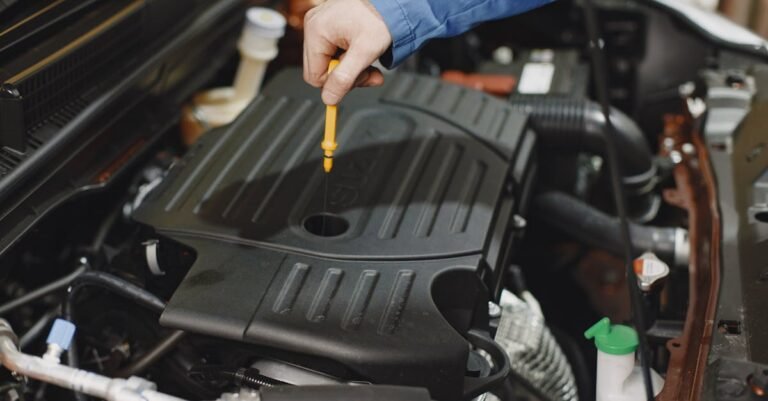**Table of Content**
- Check Engine Light On: What To Do
- That Little Light: Friend or Foe? Understanding the Check Engine Light
- First Steps: What to Do Immediately When the Light Appears
- Digging Deeper: Common Reasons Your Check Engine Light Is On
- DIY Diagnostics: Using an OBD-II Scanner
- When to Call the Professionals: Knowing Your Limits
- Can I Keep Driving with the Check Engine Light On?
- Preventing Future Check Engine Light Scares
- Conclusion: Demystifying the Dashboard Demon
- Frequently Asked Questions (FAQs)
- FAQ 1: Will tightening the gas cap make the light turn off immediately?
- FAQ 2: Can low oil cause the check engine light to come on?
- FAQ 3: How much does it typically cost to diagnose a check engine light?
- FAQ 4: Is it safe to reset the check engine light myself?
- FAQ 5: Can bad weather trigger the check engine light?
Check Engine Light On: What To Do
Picture this: you’re cruising down the road, maybe singing along to your favorite song, maybe just enjoying the drive, when suddenly… *it* appears. A little amber light glowing ominously on your dashboard. The Check Engine Light. Cue the sinking feeling in your stomach, right? We’ve all been there. That little engine symbol can trigger instant anxiety, conjuring images of massive repair bills and roadside breakdowns. But before you spiral into panic mode, take a deep breath. While you should *never* ignore the check engine light, it doesn’t always spell doom for your car or your wallet. Let’s break down what that light really means and what steps you should take when it pops up.
That Little Light: Friend or Foe? Understanding the Check Engine Light
So, what exactly is this infamous light trying to tell you? Think of it less as an enemy and more as a messenger, albeit one that delivers potentially stressful news. It’s part of your car’s On Board Diagnostics (OBD) system, specifically OBD II on vehicles manufactured since 1996. This system constantly monitors various sensors throughout your engine, powertrain, and emissions system.
What Is the Check Engine Light, Really?
At its core, the check engine light (officially known as the Malfunction Indicator Lamp or MIL) illuminates when the OBD II system detects a problem it can’t fix itself. It stores a Diagnostic Trouble Code (DTC) in its memory, indicating the specific area where the issue was detected. This could range from something incredibly simple, like a loose gas cap, to something more serious, like a failing catalytic converter. The light itself doesn’t tell you the exact problem, just that *something* requires attention.
Why It’s Not Always a Panic Button (But Still Important!)
It’s easy to jump to the worst conclusion, but many check engine light triggers are relatively minor. As we’ll discuss, things like a loose gas cap or a sensor needing replacement are common culprits. However, ignoring the light is a gamble. Even a minor issue, left unaddressed, could potentially lead to poorer fuel economy, reduced performance, or even damage to more expensive components down the line (like that pricey catalytic converter). Think of it like a toothache; ignoring it won’t make it go away and might lead to a root canal later!
First Steps: What to Do Immediately When the Light Appears
Okay, the light is on. Your heart rate might be up a bit. What now? Here’s a calm, step by step approach.
Step 1: Don’t Panic (Easier Said Than Done, Right?)
Seriously, take a moment. Panicking won’t help diagnose the issue or fix it. Observe your car’s behavior. Is it driving differently? Are there strange noises, smells, or a noticeable loss of power? Or does everything seem perfectly normal apart from the new dashboard decoration? Your observations are valuable clues.
Step 2: Check Your Gas Cap – The Surprisingly Common Culprit
This might sound silly, but it’s one of the most frequent reasons the check engine light comes on. A loose, cracked, or improperly sealed gas cap can disrupt the fuel system’s pressure, triggering the light. Pull over safely, unscrew your gas cap, and then screw it back on tightly. Make sure you hear several clicks (if your cap is designed that way) to ensure it’s properly sealed. Sometimes, the light won’t turn off immediately; it might take a few drive cycles (a mix of starting, driving, and stopping) for the system to re evaluate and turn the light off if the cap was the issue.
Step 3: Assess the Situation – Flashing vs. Solid Light
This is crucial. Is the check engine light glowing steadily, or is it flashing?
The Dreaded Flashing Light: What It Means
A flashing check engine light signals a severe problem that requires immediate attention. Usually, this indicates a serious engine misfire. What’s a misfire? It means one or more cylinders aren’t firing correctly, dumping unburned fuel into the exhaust system. This raw fuel can rapidly overheat and damage the catalytic converter, leading to a very expensive repair. If your check engine light is flashing, reduce your speed, avoid heavy acceleration, and get your vehicle to a mechanic or safely pull over and arrange for a tow as soon as possible. Don’t try to “limp it home” for miles and miles – you risk causing significant damage.
The Steady Glow: Less Urgent, Still Needs Attention
If the light is solid and not flashing, the issue is typically less severe. Your car is alerting you to a problem detected by the OBD II system, but it’s not usually an emergency requiring you to stop driving immediately (unless you notice other serious symptoms like overheating, loss of oil pressure, or major performance issues). You should still plan to get the car checked out relatively soon, ideally within the next few days. Ignoring it can still lead to worsening problems or failed emissions tests.
Digging Deeper: Common Reasons Your Check Engine Light Is On
While a diagnostic scan is the only way to know for sure, here are some of the usual suspects behind that illuminated engine symbol:
Oxygen (O2) Sensor Issues
Your O2 sensors monitor the amount of unburned oxygen in your exhaust system. This data helps your car’s computer optimize the fuel mixture for efficiency and emissions. Over time, these sensors can get fouled by oil ash, coolant, or simply wear out. A faulty O2 sensor won’t provide accurate readings, leading to decreased fuel economy (sometimes up to 40%!) and potentially damaging other components like spark plugs and the catalytic converter. Replacement is usually straightforward.
Loose or Faulty Gas Cap (Seriously, Check It Again!)
Yes, we’re mentioning it again because it’s *that* common. Even if you tightened it, the cap itself might be damaged, cracked, or have a worn seal, preventing a proper seal. It’s a cheap fix, so it’s always worth double checking or replacing if you suspect it.
Catalytic Converter Problems
This is one of the more expensive possibilities. The catalytic converter changes harmful carbon monoxide and hydrocarbons into less harmful compounds. If it fails, you’ll likely notice reduced performance, sluggish acceleration, and fail an emissions test. Catalytic converter failure is often a symptom of another underlying issue, like faulty O2 sensors or spark plugs causing unburned fuel to enter the exhaust. Regular maintenance helps prevent this.
Spark Plugs or Ignition Coils
Spark plugs ignite the air fuel mixture in the cylinders. Ignition coils provide the high voltage electricity the spark plugs need. Worn out spark plugs, damaged spark plug wires, or failing ignition coils can cause engine misfires (remember the flashing light?). This leads to rough idling, poor acceleration, reduced fuel economy, and can damage the catalytic converter. Replacing plugs and coils is part of routine maintenance, but they can fail prematurely.
Mass Airflow Sensor (MAF) Failure
The MAF sensor measures the amount of air entering the engine, helping the computer calculate the right amount of fuel to inject. If the MAF sensor is dirty or faulty, it can throw off the fuel mixture, causing rough idling, stalling, poor acceleration, and decreased fuel efficiency. Sometimes, cleaning the MAF sensor can resolve the issue, but often it requires replacement.
Vacuum Leaks
Your engine relies on vacuum pressure for various functions. Hoses can crack, dry out, or become disconnected over time, leading to vacuum leaks. These leaks disrupt the air fuel mixture, potentially causing rough idling, high idle speeds, stalling, and of course, triggering the check engine light. Finding a vacuum leak can sometimes be tricky, requiring a mechanic to perform a smoke test.
Issues with Aftermarket Alarms/Remote Starters
Improperly installed aftermarket parts, particularly alarms or remote start systems that tap into the vehicle’s wiring, can sometimes interfere with the OBD system and trigger a false check engine light. If the light appeared shortly after installing such a system, it’s worth investigating.
DIY Diagnostics: Using an OBD-II Scanner
Feeling a bit adventurous or just want to know what’s going on before heading to the shop? You can often read the Diagnostic Trouble Code (DTC) yourself.
What’s an OBD-II Scanner? Your Car’s Translator
An OBD II scanner (or code reader) is a device that plugs into the OBD II port in your car (usually located under the dashboard near the steering column). It communicates with your car’s computer and displays any stored DTCs. These scanners range from simple code readers to more sophisticated tools that provide live data streams. Many affordable options are available online or at auto parts stores, and some even connect to your smartphone via Bluetooth.
How to Use an OBD-II Scanner
Using a basic scanner is typically straightforward:
- Locate the OBD II port (check your owner’s manual if you can’t find it).
- Plug the scanner into the port.
- Turn your car’s ignition to the “On” position (without starting the engine).
- Follow the scanner’s instructions to read the codes. It will usually display a code like “P0420” or “P0301”.
- Write down the code(s).
Some auto parts stores also offer free code reading services.
Understanding the Codes (Don’t Be Intimidated!)
Okay, you have a code like P0442 (Evaporative Emission System Leak Detected – Small Leak). What now? The code itself points to the *system* experiencing a problem, but not necessarily the specific faulty part. A P0442 could be caused by that loose gas cap, a cracked hose in the EVAP system, or a faulty vent valve. You can easily search the code online (e.g., “P0442 code meaning”) to get a better understanding of the potential causes. Knowing the code gives you a starting point for diagnosis, whether you attempt a simple fix yourself (like the gas cap) or take it to a mechanic.
When to Call the Professionals: Knowing Your Limits
While an OBD II scanner is helpful, it doesn’t make you a master mechanic overnight. Sometimes, it’s best to leave it to the professionals.
Complex Codes or Symptoms
If the code points to a major component (like the catalytic converter or transmission), or if you’re experiencing significant drivability issues (stalling, overheating, strange noises), it’s wise to seek professional help. Mechanics have advanced diagnostic tools and the expertise to pinpoint the exact cause, especially when multiple codes are present or the issue is intermittent.
Lack of Tools or Expertise
Many repairs require specialized tools, lifts, or specific knowledge. If the potential fix involves more than tightening a cap or replacing an easily accessible sensor, and you’re not comfortable working on cars, don’t risk causing more damage. A simple sensor replacement can turn into a bigger headache if not done correctly.
Safety First!
Working on cars involves risks. If the repair involves getting under the vehicle, dealing with the fuel system, or complex electrical components, prioritize your safety. If you’re unsure, let a trained technician handle it.
Can I Keep Driving with the Check Engine Light On?
This is the million dollar question, isn’t it? The answer depends heavily on the situation.
The Risks Involved
As mentioned:
- Flashing Light: Absolutely not. Stop driving as soon as safely possible to prevent severe, expensive damage (especially to the catalytic converter).
- Solid Light: Driving *might* be possible, but you risk:
- Causing further damage to related components.
- Reduced fuel economy (costing you money at the pump).
- Poor performance and potential stalling.
- Failing an emissions test.
- The underlying issue getting progressively worse.
Think of it like ignoring a warning sign; sometimes you get away with it, other times it leads to bigger problems.
When It Might Be Okay (Temporarily)
If the light is solid, the car seems to be driving perfectly normally (no weird sounds, smells, or performance loss), and you’ve checked the gas cap, you can likely continue driving for a short period. However, “short period” means getting it diagnosed within a reasonable timeframe (a few days, not weeks or months). Don’t use a seemingly minor issue as an excuse to procrastinate indefinitely.
Preventing Future Check Engine Light Scares
While you can’t prevent every potential issue, proactive care can significantly reduce the chances of seeing that dreaded light.
Regular Maintenance is Key
This is the single most important factor. Following your vehicle manufacturer’s recommended maintenance schedule (found in your owner’s manual) is crucial. This includes regular oil changes, filter replacements, tune ups (spark plugs, wires), and inspections. Keeping components in good shape prevents many common problems that trigger the check engine light.
Listen to Your Car
Pay attention to how your car normally sounds and feels. If you notice subtle changes in performance, fuel economy, or hear new noises, get them checked out *before* they become serious enough to trigger the check engine light. Early intervention is often cheaper.
Use Quality Fuel and Parts
Using the recommended grade of fuel and opting for quality replacement parts (especially for critical components like sensors and spark plugs) can make a difference in longevity and performance, reducing the likelihood of premature failures.
Conclusion: Demystifying the Dashboard Demon
That check engine light doesn’t have to be a source of instant dread. While it signals that your car needs attention, understanding what it means and knowing the initial steps to take can empower you. Remember to check the gas cap, differentiate between a solid and flashing light, and consider using an OBD II scanner for preliminary diagnosis. Most importantly, don’t ignore the light! Addressing the issue promptly, whether it’s a simple DIY fix or requires a trip to the mechanic, will keep your car running smoothly, save you money on fuel, prevent more costly repairs down the road, and ensure you pass those pesky emissions tests. Think of it as your car’s way of asking for a little help – give it the attention it deserves!
Frequently Asked Questions (FAQs)
FAQ 1: Will tightening the gas cap make the light turn off immediately?
Not usually. After tightening the gas cap, the car’s computer needs time to run its diagnostic checks again. This typically requires several “drive cycles” – which involve starting the car, driving it under various conditions (city/highway speeds), and shutting it off. It might take a day or two of normal driving for the light to turn off if the loose cap was the only issue.
FAQ 2: Can low oil cause the check engine light to come on?
Generally, no. There’s a separate warning light specifically for low oil level or low oil pressure (usually resembling an oil can). While severe engine problems stemming from low oil could eventually trigger the check engine light due to misfires or other damage, the check engine light itself isn’t the primary indicator for low oil.
FAQ 3: How much does it typically cost to diagnose a check engine light?
Costs vary by location and repair shop. Many shops charge a diagnostic fee, often around $100 to $200, which usually involves reading the code(s) and performing some initial investigation. Some shops may waive this fee if you proceed with the necessary repairs with them. Remember, this is just the cost for diagnosis, not the repair itself.
FAQ 4: Is it safe to reset the check engine light myself?
You *can* reset the light using an OBD II scanner or by disconnecting the battery (though this can reset other vehicle systems too). However, simply clearing the code without addressing the underlying problem is generally a bad idea. The light will likely just come back on, and you’re ignoring a potential issue that could worsen. It’s best to fix the problem first, then clear the code or let it clear itself after repair.
FAQ 5: Can bad weather trigger the check engine light?
Sometimes, yes, indirectly. Heavy rain or driving through deep puddles could potentially cause moisture to affect sensitive electrical components or sensors (like O2 sensors), temporarily triggering the light. Extreme cold can also sometimes cause issues with sensors or fluid viscosity. If the light comes on during severe weather but goes off once conditions improve and the car dries out, moisture might have been the culprit. However, persistent light warrants a proper check.









